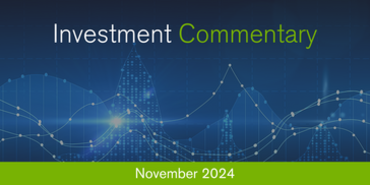Investment Commentary July 2024

July was a fairly choppy period for financial assets. A strong start to the month gave way to some weakness later on, with the main driver of the US gains this year, the Mega-cap tech stocks, faltering slightly. Despite that, most equity markets managed to end in positive territory for the month. Bonds continued to rally as a clearer path to interest rate cuts presented itself in the form of lower inflation readings and softening macroeconomic data.
The Nasdaq found itself in the unusual situation of being one of the worst performers within the major markets over the period. After hitting a fresh all-time high mid-month, the index gave up those gains and a bit more, ending the month down -0.6%. Japan was also hit by selling/profit taking after the Japanese Central Bank raised interest rates, which helped to rally a previously weak Yen. With technology stocks underperforming in the US, there was a notable rotation into previously unloved sectors such as regional banks and other cyclical sectors. This significantly boosted the Russell 2000 small-cap index, which returned +10.2% over the period. The broader S&P 500 managed a solid return of +1.2%. Elsewhere, UK and European equities advanced, posting gains of +2.5% and +1.4% respectively. There was similar rotation in these markets too, with cyclical sectors tending to do better. In Europe, peripheral equity markets, such as those of Greece, were the best performers.
For sovereign bonds, it was a strong month across the board, with Gilts, Treasuries and Eurozone sovereign bonds returning +2%, +2.2% and +1.4% respectively. This was in response to a much clearer path to interest rate cuts. The Bank of England duly delivered on the last day of the month, cutting the base rate from 5.25% to 5%. In the US, softer inflation readings meant that interest rate futures were fully pricing in a cut for their September meeting and increasing bets for further cuts for the rest of the year. According to Deutsche Bank research, the amounts of cuts priced in by the Federal Reserve’s December meeting increased by +28.4bps to 72.5bps. In the Eurozone, there was a tightening of spreads between French and German sovereign bonds as the recent political uncertainty in France eased.
One of the poorer performing asset classes over the period was commodities. There were significant declines for oil prices, industrial metals and soft commodities. Oil prices fell by around -6.6% and copper fell -4.9%. Despite some of these declines, the broader CRB Commodity Index only fell -0.8%, propped up, to a large extent, by a strong gold price, which rose +5.2% over the period.
There were also some significant moves in currency markets. After significant Yen weakness in prior months, a hawkish response from the Bank of Japan (as well as limited currency intervention) helped the Yen to snap back, strengthening by +7.3% versus the US Dollar. In fact, the Dollar had its worst month of the year, with the USD basket index falling by -1.7%. Sterling strengthened slightly against both the Euro (+0.6%) and the Dollar (+1.7%).
All figures quoted are local currency returns (and USD returns for commodities)
Clients are advised that the value of all investments can go up as well as down. Any past performance or yields quoted should not be considered reliable indicators of future returns. Opinions, interpretations and conclusions expressed in this document represent our judgement as of this date and are subject to change. Furthermore, the content is not intended to be relied upon as a forecast, research or investment advice, and is not a recommendation, offer or a solicitation to buy or sell any securities or to adopt any investment strategy.
- Date
- 31/07/2024





